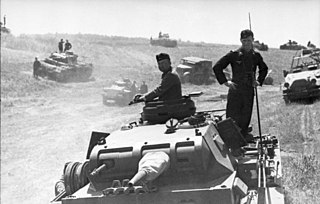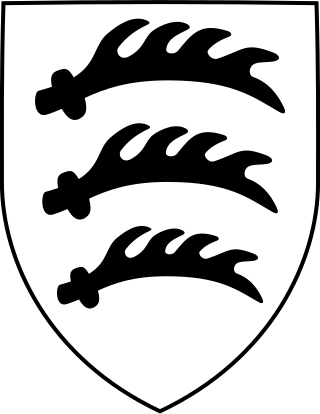
The 1st Panzer-Division was an armoured division in the German Army during World War II.
The 10th Infantry Division was created in October 1934 under the cover name Wehrgauleitung Regensburg to hide its violation of the Treaty of Versailles. It was renamed the 10th Infantry Division when the establishment of the Wehrmacht was announced publicly in October 1935.

The German 23rd Infantry Division, later the 26th Panzer Division, was a military unit operational during World War II. It was organized along standard lines for a German infantry division. It was non-motorised and relied on horse-drawn wagons for its mobility. The unit carried the nickname Grenadierkopf.

The 13th Panzer Division was a unit of the German Army during World War II, established in 1940.

The 22nd Infantry Division, which soon became the 22nd Air Landing Division, was a specialized German infantry division in World War II. Its primary method of transportation was gliders. The division played a significant role in the development of modern day air assault operations. Towards the end of the war, the formation was reshaped into the 22nd Volksgrenadier Division.

The 16th Infantry Division of the German Army was formed in 1934. On 26 August 1939 the division was mobilized for the invasion of Poland (1939). It participated in the Battle of France in August 1940. The division was then split, resulting in two independent units: The 16th Panzer Division and the 16th Motorized Infantry Division. Then later, from 1944 onward, combined with other non 16th elements, was known as the 116th Panzer Division.

The 29th Infantry Division was a unit of the German army created in the fall of 1936. It was based on the old Reichswehr 15th Infantry Regiment and drew its initial recruits from Thuringia. It was upgraded to 29th Motorized Infantry Division in the fall of 1937. The division was also known as the Falke-Division.

The 6th Panzer Division was an armoured division in the German Army, the Heer, during World War II, established in October 1939.

The German 20th Infantry Division was an infantry division of Nazi Germany.

The 17th Panzer Division was a formation of the Wehrmacht in World War II. It was formed in November 1940 from the 27th Infantry Division. It took part in Operation Barbarossa, the invasion of the Soviet Union in June 1941, and in the winter of 1941–42 participated in the Battle of Moscow. In November 1942, the division was sent to the southern sector of the Eastern Front where it participated in Operation Winter Storm, the failed attempt to relieve the surrounded troops at Stalingrad. The division was held in reserve during the Battle of Kursk in 1943, and thereafter retreated through Ukraine and Poland, before ending the war in Czechoslovakia.
The 19th Panzer Division was an armoured division in the German Army, the Wehrmacht, during World War II. It was created from the 19th Infantry Division.

The 26th Infantry Division was a pre-World War II German Infantry Division of the 1st mobilisation wave. It was mobilised for World War II on September 26, 1939, disbanded on September 10, 1944, near Radom and reformed as the 26th Volksgrenadier Division on September 17, 1944, near Poznań by absorption of the new 582nd Volksgrenadier Division of the 32nd mobilisation wave. Remnants of the Division entered U.S. captivity in the Harz region in 1945.

The 28th Jäger Division was a German military unit during World War II.
The 21st Infantry Division was a German military unit which fought during World War II.

The 14th Infantry Division was a formation of the Germany Army (Wehrmacht) which fought during World War II.

The 25th Infantry Division was a military unit of the German Wehrmacht. It was later reclassified to 25th Motorized Infantry Division, and in June 1943 to the 25th Panzergrenadier Division.

The 30th Infantry Division of the Wehrmacht was created on 1 October 1936 in Lübeck and mobilized on 26 August 1939 for the upcoming invasion of Poland. At that time, it consisted of the usual German infantry division elements: three infantry regiments of three battalions each, one three-battalion regiment of light artillery, one battalion of heavy artillery, a panzerjager (anti-tank) battalion, an aufklärungs (reconnaissance) battalion, a signals battalion, a pioneer (engineer) battalion, and divisional supply, medical, and administrative units.

The 15th Infantry Division was an infantry division of the German Army during the interwar period and World War II, active from 1934 to 1945.
The 179th Reserve Panzer Division of the German army in World War II was formed in July 1943. The division was stationed in France from July 1943 to May 1944 when it was disbanded and absorbed by the 116th Panzer Division.

The 256th Infantry Division was a German infantry division in World War II. They formed on August 1939 as part of the 4. Welle (wave). The division was destroyed at Vitebsk in June 1944 during Operation Bagration. The remnants of the division formed Divisions-Gruppe 256 which was assigned to Korpsabteilung H.















